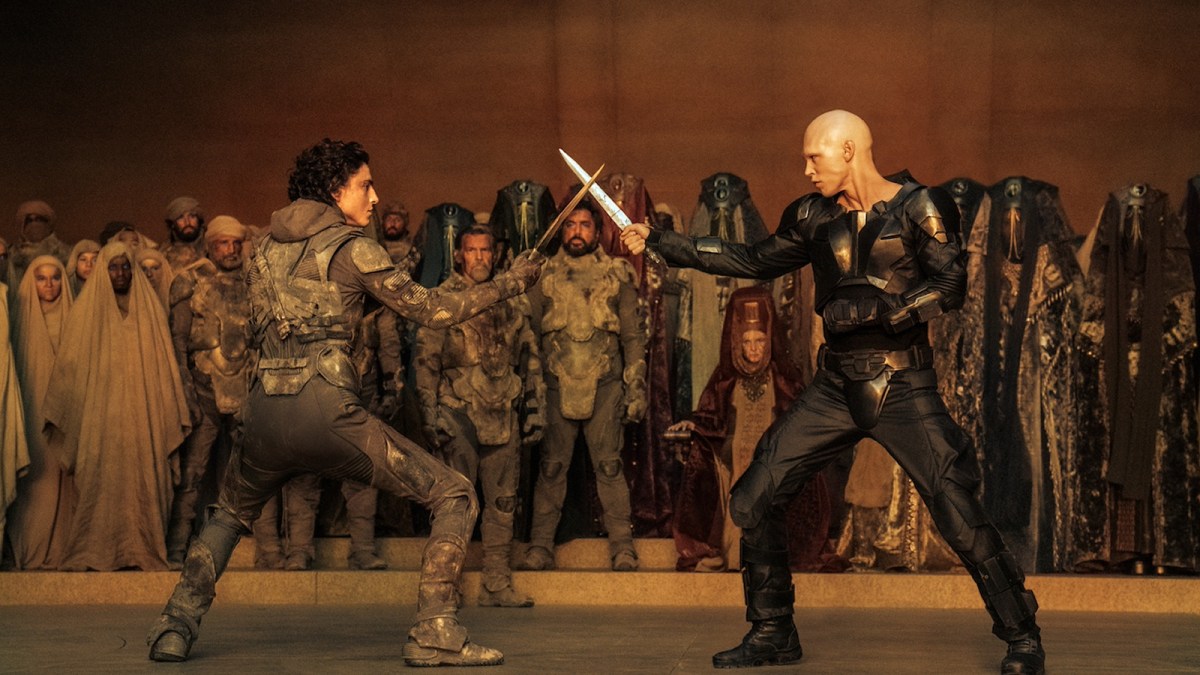Dune: Part Two wraps up two films’ worth of story – and keeping track of everything isn’t easy. So, with this in mind, we’ve explained Dune: Part Two‘s ending below, including how it differs from the finale of Frank Herbert’s original Dune novel.
Related: Dune: Part Two Is a Spectacular Spice Melange for the Mind and Senses (Review)
Dune: Part Two’s Ending, Explained
Dune: Part Two ends with Paul Atreides (Timothée Chalamet) defeating his enemies Emperor Shaddam IV (Christopher Walken) and Baron Vladimir Harkonnen (Stellan Skarsgård) and their respective Houses. He does this by adopting the title of Lisan al Gaib: the prophesized messiah of the desert planet Arrakis’ indigenous Fremen. This earns Paul the unwavering loyalty of the Fremen and their millions of deadly warriors. However, it also alienates his Fremen other half, Chani (Zendaya), who knows the prophecy is a sham cooked up by the shadowy Bene Gesserit sisterhood.
There isn’t much time for Paul and Chani to hash out their relationship issues, though. Shaddam IV and his legendary Sardaukar troops arrive on Arrakis soon after Paul issues the Emperor a “come at”-style message, which means battle planning takes priority. Paul cooks up a strategy involving the Fremen’s gigantic sandworms, his own arsenal of atomic weapons, and a massive sandstorm to overwhelm the Emperor’s troops. It works, and Paul’s forces win the day with relative ease.
Along the way, they dish out some well-deserved revenge on the Harkonnens, too. Paul personally kills Baron Harkonnen – outed as Paul’s maternal grandfather earlier in Dune: Part Two – as payback for the plus-sized baddie orchestrating the death of his father, Leto, in Dune: Part One. Meanwhile, one of Paul’s old mentors, Gurney Halleck (Josh Brolin), dispatches the Baron’s brutish nephew, Glossu Rabban Harkonnen (Dave Bautista), for his role in House Atreides’ downfall.
Related: Dune: Part Two: Who Are the Bene Gesserit, Explained
With the battle over, Paul has Shaddam IV and his entourage brought before him. He challenges the Emperor to a duel for the throne, and Baron Harkonnen’s surviving nephew, Feyd-Rautha (Austin Butler), volunteers to fight on Shaddam IV’s behalf. A nail-biting knife fight ensues, with Paul emerging victorious. Paul then moves to kill Shaddam IV, however, his daughter, Princess Irulan (Florence Pugh), intervenes. She offers to marry Paul – legitimizing his claim to the throne – if he lets her father live.
Paul agrees, although he immediately learns that other Great Houses still refuse to accept him as Emperor. They’re all hovering in orbit above Arrakis, so Paul orders his Fremen right-hand man, Stilgar (Javier Bardem), to “lead them to Paradise” – basically, wage holy war on them. Stilgar and the Fremen armies do just that, boarding ships headed for the fleet surrounding the planet. Given the Fremen’s prowess throughout Dune: Part One and Part Two, there’s little doubt about the off-screen outcome.
So, all told, Dune: Part Two ends with a complete victory for Paul – but a bittersweet one, all the same. Not only has he launched the bloody, universe-spanning conflict he spent both films trying to avert, but he’s also lost Chani. Unmoved by Paul’s insistence that he will always love her and disgusted by his new messianic persona, she returns to the desert wastes alone.
How Is Dune: Part Two’s Ending Different From Frank Herbert’s Book?
Things shake out mostly the same in Frank Herbert’s Dune, with a few key differences. For starters, Paul’s younger sister, Alia Atreides, actively participates in the book’s finale. As envisioned by Herbert, Alia is already born by the time Paul launches his assault on the Emperor and the Harkonnens. Indeed, she’s four years old, and – drawing upon her unnaturally advanced intellect and maturity – kills Baron Harkonnen, instead of Paul.
Chani’s reaction to Paul embracing the Lisan al Gaib title is also markedly different in Dune: Part Two versus the book. In the Dune novel, she’s broadly fine with Paul’s decision, whereas in the movie, it drives a wedge between them. Similarly, Herbert’s version of Chani is less miffed when Paul takes Irulan’s hand, unlike director Denis Villeneuve and co-screenwriter Jon Spaihts’ take on the character, for whom this is a relationship dealbreaker.
Related: Is Jason Momoa in Dune: Part Two? Explained
The knock-on effect of this is that, while both the book and film close on Chani, the tone of these scenes is completely different. Dune‘s final pages see Chani reassured after first Paul and then Lady Jessica reassures her that Paul’s marriage to Irulan is just for show. The latter pep talk doesn’t happen in Dune: Part Two, and Chani exits the flick disillusioned with Paul. This could also have interesting consequences for Villeneuve’s planned Dune Messiah adaptation, as Paul and Chani are still very much an item in Herbert’s follow-up novel.
These changes aside, the only other notable revision Villeneuve and co-screenwriter Spaihts make to Dune‘s finale concerns the fate of Rabban. According to Herbert, Rabban is killed by unnamed Fremen troops. However, as noted above, Dune: Part Two explicitly depicts Gurney taking out Rabban, adding a more personal dimension to the supporting villain’s demise.
Dune: Part Two is in cinemas now.






Published: Mar 4, 2024 07:11 am